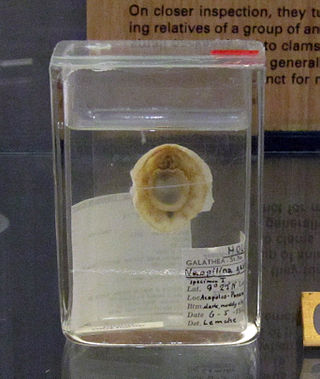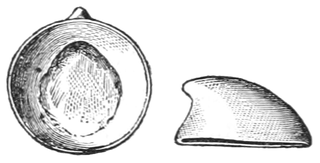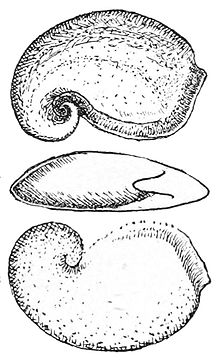
Monoplacophora, meaning "bearing one plate", is a polyphyletic superclass of molluscs with a cap-like shell, inhabiting deep sea environments. Extant representatives were not recognized as such until 1952; previously they were known only from the fossil record, and were thought to have become extinct 375 million years ago.

The Bellerophontidae are an extinct family of specialized globose bellerophontids, Paleozoic and early Triassic mollusks of the class Gastropoda.

Latouchella is an extinct genus of marine invertebrate animal, that is considered to be a mollusk and which may be a sea snail, a gastropod. It is a helcionellid from the Tommotian epoch of what is now Siberia. Its tightly coiled, spiral shell contains a number of low "walls" running up the front surface of the interior; these would have directed water currents within its shell. Between these walls are a series of furrows, parallel to the shell's aperture, giving casts of the internal structure the appearance of a railway line, with sleepers tying together paired rails that run towards the apex of the shell.

Yochelcionella is an extinct genus of basal molluscs which lived during the Tommotian epoch, the first epoch of the Cambrian period. This genus is often reconstructed to resemble snails.

Helcionellid or Helcionelliformes is an order of small fossil shells that are universally interpreted as molluscs, though no sources spell out why this taxonomic interpretation is preferred. These animals are first found about 540 to 530 million years ago in the late Nemakit-Daldynian age, which is the earliest part of the Cambrian period. A single species persisted to the Early Ordovician. These fossils are component of the small shelly fossils (SSF) assemblages.

Helcionelloida is an extinct group of ancient molluscs. These are the oldest known conchiferan molluscs, that is, they had a mineralised shell. Some members of this class were mistaken for Monoplacophorans. The class was erected by Peel in 1991.

Coreospiridae is an extinct family of Paleozoic molluscs of uncertain position taxonomically. They might be snails (Gastropoda), Helcionelloida, or they might be Monoplacophora.
Khairkhaniidae is an extinct family of Paleozoic fossil molluscs of uncertain position. They are thought to belong to either the Gastropoda or Monoplacophora. They possess planispiral coiled shells with a columnar microstructure.
Ladamarekiidae is an extinct family of Paleozoic fossil molluscs of uncertain position. it is not known if they are sea snails.
Patelliconidae is an extinct family of Paleozoic fossil molluscs. It is not known whether these were Gastropoda or Monoplacophora.

†Archinacellidae is an extinct family of paleozoic molluscs of uncertain position.
†Archaeopragidae is an extinct family of paleozoic molluscs of uncertain position.
Aldanellidae is an extinct family of paleozoic molluscs that have been assigned to the Gastropod stem group but may also belong to a paraphyletic "Monoplacophora".
Carinopelta is a genus within Carinopeltidae, an extinct family of Cambrian molluscs of uncertain position. It is in the superfamily Scenelloidea.
Trenella is the sole genus in the Trenellidae, an extinct family of paleozoic Yochelcionellids.
Stenothecidae is an extinct family of fossil univalved Cambrian molluscs which may be either gastropods or monoplacophorans.

Tremanotidae is an extinct family of Paleozoic fossil molluscs with isostrophically coiled shells. They occupy an uncertain position taxonomically: it is not known whether they were (gastropods or monoplacophorans.
Pelagielloidea is an extinct superfamily of Paleozoic fossil molluscs of uncertain position, either.

Yochelcionelloidea is an extinct superfamily of paleozoic molluscs of uncertain position. The earliest yochelcionellids are known from the Middle Tommotian, but they are most diverse from the Botomian through the early Middle Cambrian.
This overview lists proposed changes in the taxonomy of gastropods at the family level and above since 2005, when the taxonomy of the Gastropoda by Bouchet & Rocroi (2005) was published. In other words, these are recent updates in the way various groups of snails and slugs are classified.




